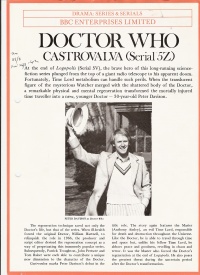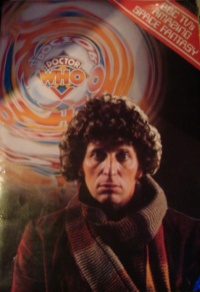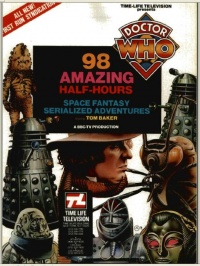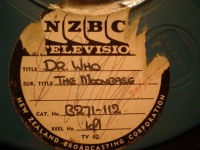Buying and Selling
BUYING DOCTOR WHO
The process of selling and buying TV programmes has its complexities, and differs from country to country. This section offers a general overview of the sorts of processes that are known to have been applied to Doctor Who.
SELLING A TV SERIES
Like many programme-makers, the BBC had its own sales division, BBC Enterprises Limited (later BBC Worldwide). Enterprises had its own sub-agencies, BBC Toronto, in Canada, and BBC Sydney, in Australia. BBC Sydney catered for the Asian market.
Another agency that acted on the BBC's behalf was Television International Enterprises Ltd. TIE Ltd serviced countries in the Caribbean, Africa and the Middle East.
Sellers or distribution agents would make programme buyers aware of product by sending out promotional literature. For Doctor Who the BBC produced story synopses, such as the ones available as PDFs on the Peladon DVD box set. (Presented here is the one for Castrovalva.)
Other literature in the form of industry journals, publications and magazines, such as Broadcasting, Variety, were also referenced to see and judge what programmes were considered popular in other countries.
An annual television sales junket is the MIPTV Media Market, held annually in Cannes, France.
Sellers, distributors (such as Time Life Films / Television; Television International Enterprises Ltd) and buyers also attended programme sales junkets: the BBC Showcase is held at Brighton every year; it was during the February 1977 sales fair that sales to Europe fell through (see Europe, while another similar sales junket in July 1985 in Nassau resulted in sales to nine Caribbean countries.
BUYING A TV SERIES
Audition
Programme buyers could choose and select only the stories which interested them; they were under no obligation to buy entire "seasons", a fact evidenced by the number of Doctor Who stories that didn't air in some countries.
After an agreement had been made to buy a series, the programme selector would often request to view an "audition", "pilot" or "viewing" copy. This was a sample of one for more episodes so they could judge whether the programme was worthy of buying. (Often sellers would entice potential buyers by providing copies of only the best episodes as auditions!)
During the 1960s, "audition" prints of Doctor Who were often sent from another broadcaster. It is known that the NZBC (New Zealand) supplied Denmark with prints of the first three William Hartnell stories, while Iran was supplied with episodes one and two only of Marco Polo. (Of the two, only Iran ended up buying the series on the basis of these "auditions"!)
Clearances
Once a buyer had selected the programmes and episodes, an agreement to purchase was made.
In New Zealand the purchasing contracts contained a "Rights and Restrictions" clause, which basically specified the period within which the programme must be played - usually a term of two to three years. Repeats are also negotiated if required.
To this end, a fee was paid to the seller for the rights clearances. Clearing the rights was sometimes a tricky and complex process, as different fees applied to different countries, based on geographical location (e.g. Africa, North America, Asia), language and whether or not they were part of the British Commonwealth. Rights had to be negotiated with the actor's union Equity, the Writers' Guild and Musicians' Union, who set the various levels of fees payable. (It was Equity who limited the number of sales and repeats the BBC could complete, which ultimately resulted in the junking of all the now-missing episodes...)
Of note, clearances were sometimes payable only once per territory or region, rather than by individual countries. Therefore the clearance fees were covered in full by the first country in that region to buy a series or episodes. Subsequent purchasers in that territory didn't have to pay any more than their negotiated price. (This is why many countries are often missing from BBC Records. There was a financial advantage to being down the pecking order, although one would get second hand rather than brand new prints as a consequence!)
Different broadcasters had negotiated maximum fees for buying programmes. Countries in which there were more than one broadcaster usually paid a much higher fee, to beat off the competition, whereas those countries that had only one broadcaster could negotiate a much lower fee.
To better explain the clearances and costs associated with buying BBC programmes, these comments from several articles on programme buying that appeared in the The New Zealand Listener (*) offer very clear insights into the sales process:
- Prices vary according to what the market will bear: in Australia, an hour costs $4500, whereas in Germany it may be as high as $7000. In New Zealand, the NZBC paid between $300 and $400. (Values in New Zealand Dollars). (In the pre-decimal 1960s, the NZBC paid £100 per hour, and £50 per half hour.)
- Small countries like New Zealand miss getting some programmes because bigger neighbours are not interested and they cannot pay the BBC's costs alone. (This is why Doctor Who serials rejected in Australia end up not being sold to other Commonwealth countries.)
- Musician's Union in the UK costs are considerably high
- In the 1960s, the BBC found selling to the United States very tough because sponsors were frightened of offending minority groups, and non-US programmes often contained material that could be considered controversial
- The initial expenses – administration and copyright – have to be met early on in the sales process, so a sale to a major market like Australia covers those costs before the programme is even offered anywhere else
- Most programmes bought by the NZBC have been sold previously to Australia or Canada, who pay for all the upfront costs that NZBC can't afford to pay on its own
- The ABC in Australia has first refusal on all BBC programming
- The first refusal offer to major broadcasters was as a result of an agreement at a Commonwealth Broadcasting Conference, in that older Commonwealth broadcasting agencies would work together
- Not all programmes are immediately available for sale to New Zealand. When there are "residuals" to clear, a sale to the higher-paying Australian market must be made before TVNZ can buy. "Residuals" are payments to creative people – director and actors – at the time the programme is sold, and the complex rules vary from company to company
These clearances paid for the residuals that were due to the contracted actors, the script writer, and for the use of music (both stock or specially composed scores). (Any of these persons could refuse to allow a sale to go ahead, for political, religious or other reasons; of course it was rare for this to happen with Doctor Who, as it would deny that person an income. The only documented instance in which a writer prevented the BBC from selling Doctor Who episodes overseas was when Terry Nation withdrew the rights to his Dalek stories while he attempted to sell his Dalek spin-off series idea to American networks during 1966 and 1967.)
The fee also covered the rights expiry period. The rights expiry period was essentially the time needed for the broadcaster to acquire, prepare, schedule and screen a programme. And given that the acquisition period (see below) sometimes took months - or years even - five years was sufficient if not generous. (And if it had been negotiated, also allowed for a repeat screening.) For Doctor Who this period ranged at times from three to five years. (When the rights period expired and there had been no further sales, the programme or episodes were withdrawn from offer. For instance, by mid-1974, the BBC was still offering these William Hartnell stories for sale: Inside the Spaceship, The Web Planet, The Space Museum, The Time Meddler, Galaxy 4 and - curiously – Mission to the Unknown. However, by mid-1975, this list had reduced to just the middle four stories of that list. As it so happens, Nigeria is the only country known to have bought anything from this list of stories.)
Acquisition
Once all the fees had been paid (or agreement reached to pay later), it was up to the buyer to source and acquire the prints. The seller would supply the buyer with a list of broadcasters who had previously bought the series, and the new buyer would contact them to arrange the importation of the film prints or tapes, at their own cost. (To reduce transportation costs, it was usual for broadcasters to source prints and tapes from countries in the same continent or region.)
Sometimes when the prints eventually arrived from a foreign country, some were unusable; being in the wrong format or language, or not the ones that were ordered. This meant a broadcaster had to try and source replacement copies from somewhere else. (If necessary, the original distributor or seller might be required to provide copies from their own stocks.) This time-consuming acquisition process often justified why a five year rights period was often essential.
Censorship
Acquired programmes then went through the censorship process. Much has been documented about the Australian and New Zealand censorship of Doctor Who. (Censor clips have been recovered from both countries.) Little else is known about the censorship processes of other countries; it is however known that Hong Kong had very strict censorship controls.
Sometimes strict censorship meant that a programme or episode could not be aired. In the case of Australia, the government censors assigned classification ratings to some serials which meant they could not be aired in the early evening timeslots sought by the broadcaster. It is for this very reason that eight Doctor Who stories were "banned" from Australian screens in the 1960s and 1970s. And because those stories had been "banned" there, other Commonwealth or Asian countries could not buy them, because they were relying on Australia footing the clearances costs.
And should a programme or episode be unable to screen, then the clearances would no longer be payable (and if already advanced, be refunded or held on credit).
Censorship was not the only reason why certain stories did not / could not be aired. Other factors could be:
- cost (the broadcaster might only have a budget for X episodes)
- scheduling (the broadcaster might only have available slots for only X episodes)
- prints not available (there are no available copies in circulation; other stations had not yet screened the prints they had)
- prints unusable (e.g. due to damage)
- language (Arabic and Spanish-speaking countries could buy only those stories that had been dubbed into those languages)
- expiry of rights (the agreed rights periods had expired)
After broadcast
Once a broadcaster had aired the programme, they would usually be instructed to:
- (a) send the prints or tapes onto the next broadcaster who requested them (either the full set or just part);
- (b) send some as "audition" prints to different potential buyers;
- (c) return the material to the original distributor or agent;
- (d) destroy the material...
This slapdash 'disposal' process is partly why the BBC's film library and archives held odds and ends and very few complete stories; that was all that had been returned to them from overseas...
Summary
This general overview touches upon many of the main points surrounding selling and buying Doctor Who. There may be other factors and steps in the process that have not been taken into account here, but what is covered does give one a good feel for all the wheres, whys and hows that went into selling Doctor Who to the 70+ countries featured in BroaDWcast...
.
Links
- Main Page
- Broadcasts around the World
- Articles & Analysis
- Selling Doctor Who
- BBC Records
- Doctors
- Airdates
- Spanish
- Arabic
(*) New Zealand Listener 2 April 1965; 28 March 1969; 19 December 1969; 12 August 1978; 30 July 1983



